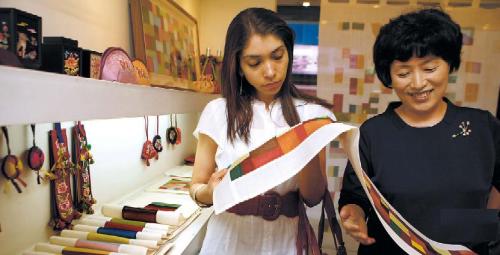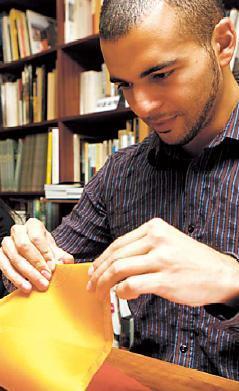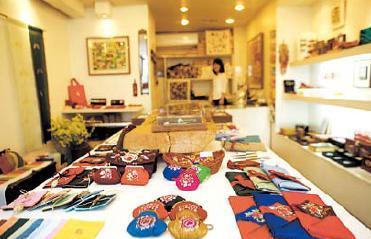[Rediscover Seoul (83)] Bojagi ? Korean traditional gift wrapping cloth
ByPublished : May 16, 2011 - 16:05
This is the 83th in a series of articles highlighting tourism spots in Seoul. The guide for planning weekend trips in the capital city will help readers rediscover Seoul. — Ed.

The door opened with a rattling sound. Wind blew through the door and tickled a corner of the window screen. Behind the ramie patchwork screen, night was falling on the alley outside. As the alley became darker, the lights of the stores got brighter. Colorful craft works, such as bojagi, fabric pouches, thimbles and pillows caught people’s eyes.
Viola Mickova from South Africa looked closely at colorful embroidered thimbles and silk patchwork bojagi. Even though she has been living in Korea for three years, it was the first time for her to see Korean traditional craftwork this close up.
Laila from France was not familiar with these Korean traditional crafts, in such a full range of colors, either. It has been one and half years since she moved to Korea. The only cultural experience that she had had in Korea was roasting green tea leaves.
For Jed from France, who is in Korea to visit his girlfriend, Laila, it was only his second day in Korea.
These three people have one common thing in mind. They want to have various cultural experiences while they are in Korea.
Kang Yun-ji volunteered to make their wishes come true. She wanted to introduce beautiful Korean culture to her colleague Mickova who is very interested in Korean culture. I have known Kang since we participated in a metal craft workshop at Seoul Art Space Sindang. We found out about gyubang gongyae craft workshop.
Art created by Korean noble women

“Gyubang gongyae” originated from ladies of noble families in the Joseon Dynasty. Ladies created various daily goods by sewing, such as patchwork cloths, “norigae” (Korean traditional ornaments worn by women), and pillow ends.
The society in the Joseon Dynasty was strictly ruled by Confucianism, where grown women were not allowed to go out freely. The living spaces for ladies of noble families were in the deepest part of the house, called “byeolchae.” Ladies could not go out as they wished, and strangers were also strictly restricted in the ladies’ area.
What they could do was sewing and embroidery. On fine fabric, they embroidered stitches, and quilted patches of leftover pieces of clothing to make patchwork clothes. They made craftworks used mostly in daily life, such as tablecloths, teapot covers, cases for scissors, needles, irons and spoons, as well as thimbles, norigae, pillow ends, medicine pouches, scent bags and pin cushions.
Gyubang gongyae used pieces of hemp ramie and silk leftover from making hanbok or bedding.
However, gyubang gongyae crafts do not look like they are made of leftover scraps. The craftworks created by the delicate fingers of Korean women naturally reveal the colorful souls of Korean women, and Korean culture.
The most famous type of craftwork is “bojagi.” Bojagi is the simplest item used for wrapping, storing and moving things. It also has a ceremonial purpose to maintain a high level of etiquette and formality. Bojagi was called by many different names such as bo (褓), boja (褓子), bog (福), or called bojaegi, podaegi, bangsugeon, and bapppujae in different regions of the country.
To see various works of gyubang gongyae, you should go to Insa-dong, one of Korea’s leading tourist spots. Among the many stores located along the alleys of Insa-dong, there are a number of gyubang gongyae specialty stores. Some products maintain a traditional look while some are re-interpreted to suit our modern way of living. Modern-style gyubang gongyae products include necklace pendants decorated with patchwork bojagi, mobile phone accessories with mushroom-shape ornaments, and key rings with fabric pouches. These are some products with which you can incorporate gyubang gongyae craftwork into your daily life.
Make a gift wrapping cloth full of beautiful colors

A class on making gift wrapping cloth was held in Sopri, a gyubang gongyae specialty store in Insa-dong. Sopri displays and sells gyubang gongyae craftworks created by 20 artists in Korea. As you see various craftworks in the store, you can understand the use of the craftworks and how to make them. In addition, Sopri provides a gyubang gongyae workshop program for international residents and visitors who are interested.
Mickova, Laila, Jed and Kang were surprised by the fancy colors of gyubang gongyae craftworks. Viola said the works were beautiful and expressed curiosity in the craft. Michova tried on a necklace with a pendant decorated with patchwork bojagi. After looking around the shop, they moved to the workshop area.
“In the past, Korean people stored all things wrapped. Clothes and bedding were always wrapped. In addition, when they sent gifts to neighbors, bojagi served as gift wrapping. Gift wrapping paper is not reusable, but bojagi is a perfectly reusable gift wrap. It doesn’t matter what the shape of the object is -- round or a cube -- bojagi can cover it. It’s like Korean people’s hearts. ”
“Jogakbo” (patchwork bojagi) artist, Yu Eun-hui, introduced jogakbo. Michova, Laila and Jed held needles in their hands, looking quite awkward. Since Mickova always has her clothes altered at a drycleaners, it has been quite a long time since she has done any sewing. The start, threading the needle, was not an easy task for them. Silk threads were too slippery to get into the eye of the needle. In the case of the French couple, Jed was a little bit better than Laila. He learned how to sew faster than his girlfriend. He even threaded a needle for Laila.
“The outer shell and the lining of bojagi are made in different colors. Hanbok, the Korean traditional costume, also uses different colors for jacket and skirt. Since the color combination is complementary, it catches people’s eyes.”
Yu already had prepared demonstration pieces with silk material. Pale green, yellow, red, and lavender colors were selected for the outer shell by each participant. Mickova started sewing with big stitches and Yu advised her to make stitches short. The color of thread was a complementary color to the clothes. Red was used most, because traditionally, red was used to expel demons.
“This fabric is for hanbok, purchased by my mother 30 years ago. My mother used to sew hanbok by hand. Look at the pattern and weaving of this fabric. They are delicate and very tight. Unmarried girls used to wear green or yellow green jackets, while just-married ladies wore red jackets.”
While sewing patchwork bojagi, Yu told us about Korean culture. When sewing the outer shell and lining of bojagi, I left 5-6cm of seam un-sewn. This would be the hole with which to turn the bojagi inside out. Before turning it inside out, I folded the seam of the four corners into a right angle and kept holding the corner while turning it inside out. Then I sewed the un-sewn seam carefully so that the stitches could not be seen from the outside. The last step was to attach brown ribbon to one corner of the Bojagi.
The steps to make a gift wrapping bojagi, from threading a needle, making a knot at the end of thread, sewing, to attaching a ribbon, were simple but each step made us laugh since we were not familiar with all of the skills.
After an hour and a half, we finally completed making some colorful bojagi gift wraps. The gift to wrap was a letter. I put the letter on the bojagi, and folded it to wrap the letter. After tying it with a ribbon, I was done. The Korean style of tying the ribbon has one loop, which is different from a regular bow. The knot is the same shape as the jacket tie of a hanbok.
We all fell in love with the beautiful colors of bojagi. Michova said that she wanted to write a letter and give it to herself as a gift. The Bojagi we made were so beautiful that we didn’t want to give them away! Well, I wanted to write a love letter to my future boyfriend, wrap it with my bojagi, and give it to him.
Since bojagi is reusable, it can be used again to wrap another gift for somebody else. Laila said that she would give the bojagi wrapped letter to her mother on Mother’s Day. She said that it would be a very special gift for her mother. Jed gave his bojagi-wrapped letter to his girlfriend, Laila. At that time, the workshop was filled with happiness for her. Kang planned to give the bojagi to her friend. Whoever receives the gift, it will be a most special one because of the handmade bojagi gift wrapping. Our bojagi-making class was an experience which immersed my body and soul in beautiful colors.

Gyubang gongyae class at Sopri
Mickova, Laila, Jed and Kang were surprised by the fancy colors of gyubang gongyae craftworks. Viola said the works were beautiful and expressed curiosity in the craft. Michova tried on a necklace with a pendant decorated with patchwork bojagi. After looking around the shop, they moved to the workshop area.
“In the past, Korean people stored all things wrapped. Clothes and bedding were always wrapped. In addition, when they sent gifts to neighbors, bojagi served as gift wrapping. Gift wrapping paper is not reusable, but bojagi is a perfectly reusable gift wrap. It doesn’t matter what the shape of the object is -- round or a cube -- bojagi can cover it. It’s like Korean people’s hearts. ”
“Jogakbo” (patchwork bojagi) artist, Yu Eun-hui, introduced jogakbo. Michova, Laila and Jed held needles in their hands, looking quite awkward. Since Mickova always has her clothes altered at a drycleaners, it has been quite a long time since she has done any sewing. The start, threading the needle, was not an easy task for them. Silk threads were too slippery to get into the eye of the needle. In the case of the French couple, Jed was a little bit better than Laila. He learned how to sew faster than his girlfriend. He even threaded a needle for Laila.
“The outer shell and the lining of bojagi are made in different colors. Hanbok, the Korean traditional costume, also uses different colors for jacket and skirt. Since the color combination is complementary, it catches people’s eyes.”
Yu already had prepared demonstration pieces with silk material. Pale green, yellow, red, and lavender colors were selected for the outer shell by each participant. Mickova started sewing with big stitches and Yu advised her to make stitches short. The color of thread was a complementary color to the clothes. Red was used most, because traditionally, red was used to expel demons.
“This fabric is for hanbok, purchased by my mother 30 years ago. My mother used to sew hanbok by hand. Look at the pattern and weaving of this fabric. They are delicate and very tight. Unmarried girls used to wear green or yellow green jackets, while just-married ladies wore red jackets.”
While sewing patchwork bojagi, Yu told us about Korean culture. When sewing the outer shell and lining of bojagi, I left 5-6cm of seam un-sewn. This would be the hole with which to turn the bojagi inside out. Before turning it inside out, I folded the seam of the four corners into a right angle and kept holding the corner while turning it inside out. Then I sewed the un-sewn seam carefully so that the stitches could not be seen from the outside. The last step was to attach brown ribbon to one corner of the Bojagi.
The steps to make a gift wrapping bojagi, from threading a needle, making a knot at the end of thread, sewing, to attaching a ribbon, were simple but each step made us laugh since we were not familiar with all of the skills.
After an hour and a half, we finally completed making some colorful bojagi gift wraps. The gift to wrap was a letter. I put the letter on the bojagi, and folded it to wrap the letter. After tying it with a ribbon, I was done. The Korean style of tying the ribbon has one loop, which is different from a regular bow. The knot is the same shape as the jacket tie of a hanbok.
We all fell in love with the beautiful colors of bojagi. Michova said that she wanted to write a letter and give it to herself as a gift. The Bojagi we made were so beautiful that we didn’t want to give them away! Well, I wanted to write a love letter to my future boyfriend, wrap it with my bojagi, and give it to him.
Since bojagi is reusable, it can be used again to wrap another gift for somebody else. Laila said that she would give the bojagi wrapped letter to her mother on Mother’s Day. She said that it would be a very special gift for her mother. Jed gave his bojagi-wrapped letter to his girlfriend, Laila. At that time, the workshop was filled with happiness for her. Kang planned to give the bojagi to her friend. Whoever receives the gift, it will be a most special one because of the handmade bojagi gift wrapping. Our bojagi-making class was an experience which immersed my body and soul in beautiful colors.

Gyubang gongyae class at Sopri

Sopri, a gyubang gongyae craft shop located at an Insa-dong alley, is a showcase and store of craftworks created by 20 gyubang gongyae artists. Craftworks in Sopri range from very traditional gyubang gongyae crafts to modernized style, providing a variety of choices. The friendly staff of Sopri also provide explanations of Korean traditional gyubang gongyae. From June, Sopri offers a program that allows you to make gift wrapping or a fabric pouch that non-Koreans can easily follow. The program takes two hours, and there are approximately 10 places in the class. The program is a good opportunity to feel and experience Korean traditional culture.
For information: Sopri 02-725-2996, 723-2996
Address: 197-4 Gwanhun-dong, Jongno-gu, Seoul
By Kim Yeon-mi







![[Graphic News] More Koreans say they plan long-distance trips this year](http://res.heraldm.com/phpwas/restmb_idxmake.php?idx=644&simg=/content/image/2024/04/17/20240417050828_0.gif&u=)
![[KH Explains] Hyundai's full hybrid edge to pay off amid slow transition to pure EVs](http://res.heraldm.com/phpwas/restmb_idxmake.php?idx=644&simg=/content/image/2024/04/18/20240418050645_0.jpg&u=20240419100350)





![[From the Scene] Monks, Buddhists hail return of remains of Buddhas](http://res.heraldm.com/phpwas/restmb_idxmake.php?idx=652&simg=/content/image/2024/04/19/20240419050617_0.jpg&u=20240419175937)

![[KH Explains] Hyundai's full hybrid edge to pay off amid slow transition to pure EVs](http://res.heraldm.com/phpwas/restmb_idxmake.php?idx=652&simg=/content/image/2024/04/18/20240418050645_0.jpg&u=20240419100350)

![[Today’s K-pop] Illit drops debut single remix](http://res.heraldm.com/phpwas/restmb_idxmake.php?idx=642&simg=/content/image/2024/04/19/20240419050612_0.jpg&u=)